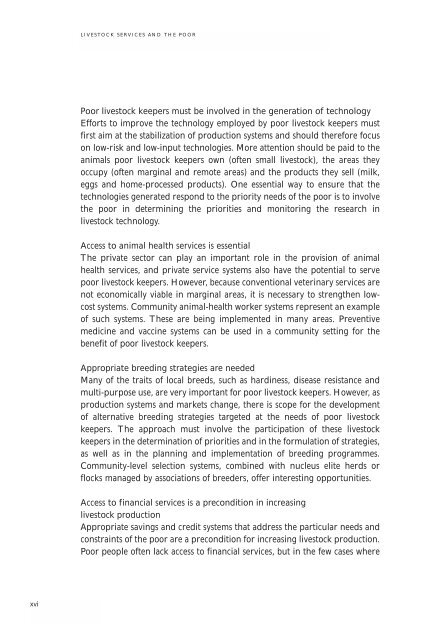Livestock Services and the Poor: A global initiative - IFAD
Livestock Services and the Poor: A global initiative - IFAD
Livestock Services and the Poor: A global initiative - IFAD
You also want an ePaper? Increase the reach of your titles
YUMPU automatically turns print PDFs into web optimized ePapers that Google loves.
xvi<br />
LIVESTOCK SERVICES AND THE POOR<br />
<strong>Poor</strong> livestock keepers must be involved in <strong>the</strong> generation of technology<br />
Efforts to improve <strong>the</strong> technology employed by poor livestock keepers must<br />
first aim at <strong>the</strong> stabilization of production systems <strong>and</strong> should <strong>the</strong>refore focus<br />
on low-risk <strong>and</strong> low-input technologies. More attention should be paid to <strong>the</strong><br />
animals poor livestock keepers own (often small livestock), <strong>the</strong> areas <strong>the</strong>y<br />
occupy (often marginal <strong>and</strong> remote areas) <strong>and</strong> <strong>the</strong> products <strong>the</strong>y sell (milk,<br />
eggs <strong>and</strong> home-processed products). One essential way to ensure that <strong>the</strong><br />
technologies generated respond to <strong>the</strong> priority needs of <strong>the</strong> poor is to involve<br />
<strong>the</strong> poor in determining <strong>the</strong> priorities <strong>and</strong> monitoring <strong>the</strong> research in<br />
livestock technology.<br />
Access to animal health services is essential<br />
The private sector can play an important role in <strong>the</strong> provision of animal<br />
health services, <strong>and</strong> private service systems also have <strong>the</strong> potential to serve<br />
poor livestock keepers. However, because conventional veterinary services are<br />
not economically viable in marginal areas, it is necessary to streng<strong>the</strong>n lowcost<br />
systems. Community animal-health worker systems represent an example<br />
of such systems. These are being implemented in many areas. Preventive<br />
medicine <strong>and</strong> vaccine systems can be used in a community setting for <strong>the</strong><br />
benefit of poor livestock keepers.<br />
Appropriate breeding strategies are needed<br />
Many of <strong>the</strong> traits of local breeds, such as hardiness, disease resistance <strong>and</strong><br />
multi-purpose use, are very important for poor livestock keepers. However, as<br />
production systems <strong>and</strong> markets change, <strong>the</strong>re is scope for <strong>the</strong> development<br />
of alternative breeding strategies targeted at <strong>the</strong> needs of poor livestock<br />
keepers. The approach must involve <strong>the</strong> participation of <strong>the</strong>se livestock<br />
keepers in <strong>the</strong> determination of priorities <strong>and</strong> in <strong>the</strong> formulation of strategies,<br />
as well as in <strong>the</strong> planning <strong>and</strong> implementation of breeding programmes.<br />
Community-level selection systems, combined with nucleus elite herds or<br />
flocks managed by associations of breeders, offer interesting opportunities.<br />
Access to financial services is a precondition in increasing<br />
livestock production<br />
Appropriate savings <strong>and</strong> credit systems that address <strong>the</strong> particular needs <strong>and</strong><br />
constraints of <strong>the</strong> poor are a precondition for increasing livestock production.<br />
<strong>Poor</strong> people often lack access to financial services, but in <strong>the</strong> few cases where

















